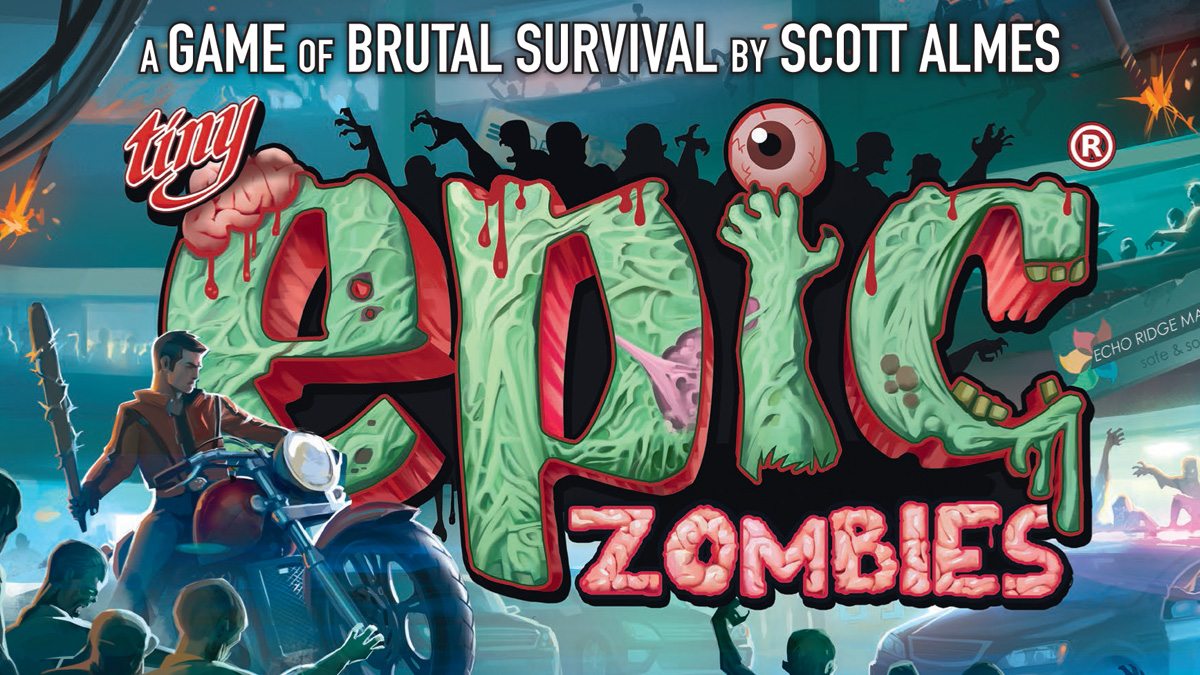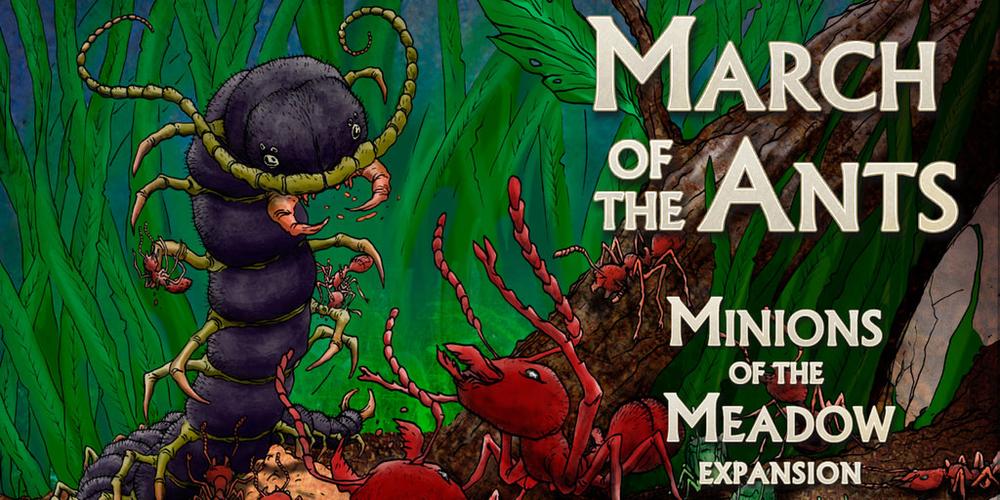They might be tiny, but these zombies are no joke. Scott Almes and Gamelyn Games are back with the latest title in their Tiny Epic series, Tiny Epic Zombies!
What Is Tiny Epic Zombies?
Tiny Epic Zombies is a game for 1 to 5 players, ages 14 and up, and takes about 30 minutes to play. It has several play modes: with or without a zombie player, and cooperative or competitive for the human players, plus a solo mode. It’s currently seeking funding on Kickstarter, with a pledge level of $20 for a copy of the game (or $25 for the deluxe version). I’d say the age rating is largely for the theme—the rules themselves are not too difficult for younger players, so I think kids who aren’t put off by the zombie theme and artwork could play it even at a younger age.
New to Kickstarter? Check out our crowdfunding primer, and visit our Kickstarter curated page for more projects we love.
Tiny Epic Zombies Components
Note: My review is based on a prototype copy, so it is subject to change and may not reflect final component quality. My copy also includes some cards that may be added later as stretch goals, so you may see glimpses of those in the photos, though I’ve tried to stick with things that are already known to be included.
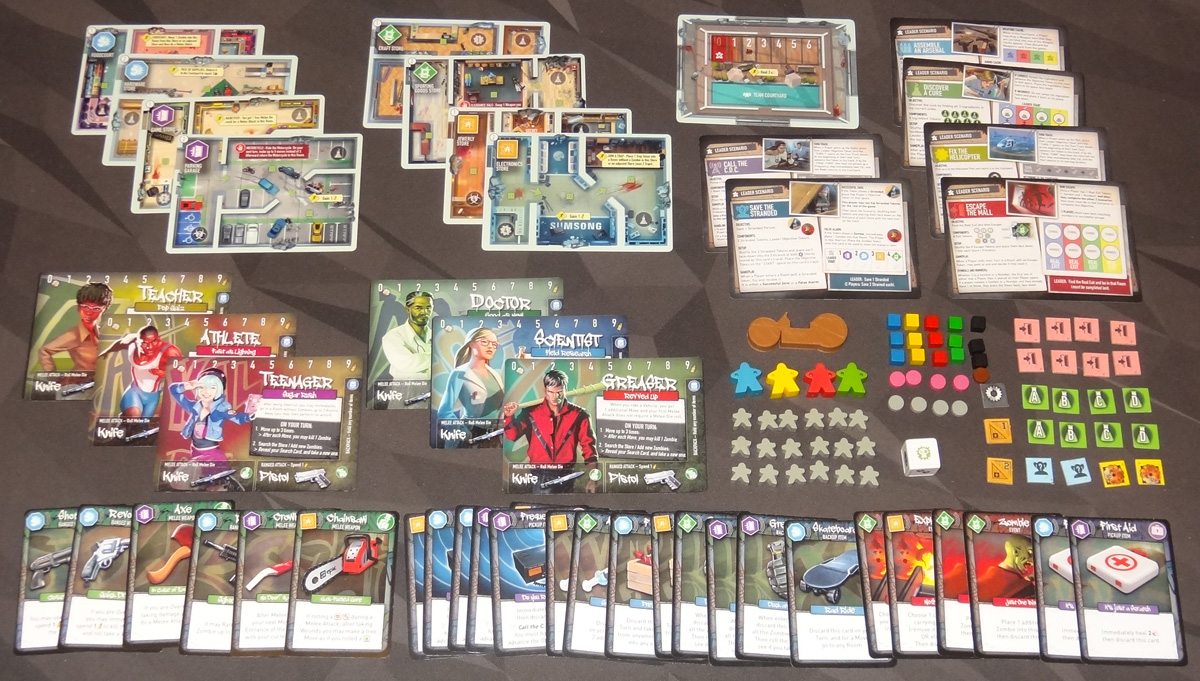
The base game includes:
- 4 ITEMeeples
- 6 Weapon Items
- Motorcycle
- Zombie die
- 18 Zombie meeples
- 28 Tracker tokens (wounds, ammo, supplies, and more)
- 26 Search cards
- 9 Mall cards
- 6 Player cards
- 6 Scenario cards
- 22 scenario tokens
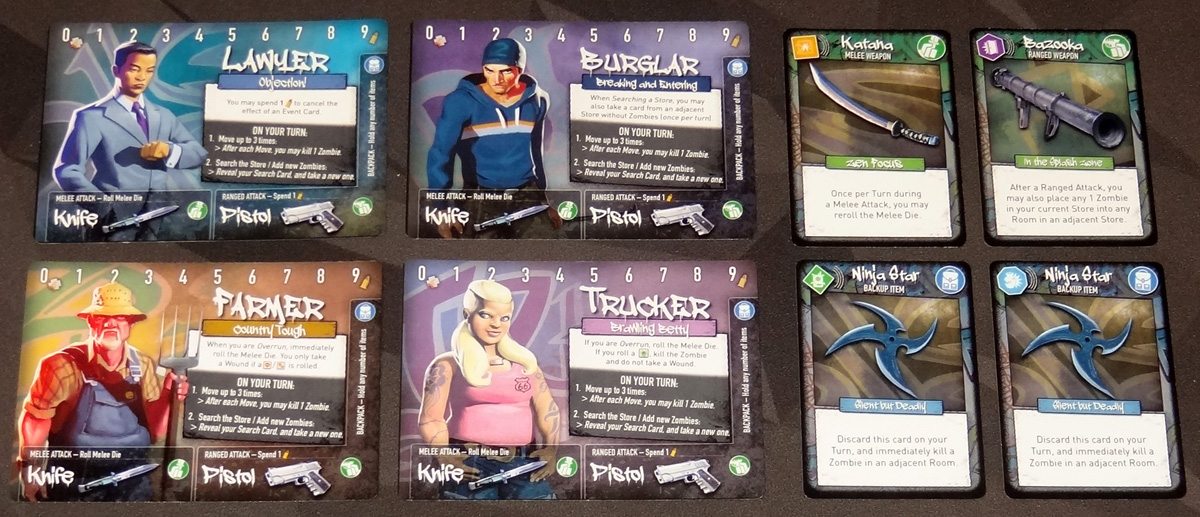
The deluxe edition will additionally include:
- 2 Weapon Items
- 4 Search cards
- 4 Player cards
In case you’re not familiar with the Tiny Epic series, each of these games comes in a small box, but it’s packed to the brim. The maps, characters, and scenarios are all oversized cards, and the search cards are standard sized cards. I’m always impressed by how much they’re able to fit into this small box size, and I love the concept of big things in small packages.

The ITEMeeples are a component that Gamelyn Games created originally for Tiny Epic Quest, and they’re pretty awesome. They’re plastic meeples, a bit larger than your standard wooden meeple, and they have small holes in the hands so that they can hold tiny plastic items. Your character picked up a chainsaw? Great—take the chainsaw card, and then pop the little chainsaw into the meeple’s hand. In Tiny Epic Quest, each player controlled three identical meeples so the ITEMeeples really served to distinguish which meeple was carrying which equipment. That’s not as necessary here, because each player has one meeple and you can distinguish them by color, but it still looks pretty awesome to have a fully armed meeple on the board. (Since the Tiny Epic Zombies items haven’t been made yet, all I have so far is items from Tiny Epic Quest as a sample.)

The mall cards each depict a store (and one central courtyard), with three rooms to each store. The artwork in the stores is nice, with lots of little details of a mall in ruins. There are holes knocked into many of the walls, with concrete rubble surrounding them. The one tricky thing is that although there are only holes pictured on some of the walls, you can actually move to any rooms that are adjacent to you, even through walls, so that can get a little confusing visually. There are also many icons on mall cards, many of them used for particular scenarios—some of these icons are grey, which makes them a little subtle when you’re looking for “biohazard symbol #2.”

The player cards are fun: each one features a particular character: a teenager, a doctor, a fry cook, a mall cop. Each character has its own special ability, and there’s also a track at the top for your wounds and ammo, and a turn summary in the center. The character illustrations are by Miguel Coimbra and are nicely done; they’re really character archetypes but they have a lot of personality. The flip side of the player cards is a zombie version of the character, with its associated zombie powers. I like the variety and diversity of people included. My only gripe about these is the sexy scientist zombie with the torn-open shirt—really?—but I do like the rest of it.

There are various tokens and markers used for tracking health and ammo and progress on the various scenarios—my prototype just used discs and cubes, so I don’t know what the final components will look like. In many of the Tiny Epic games, stretch goals have turned those into custom shapes.
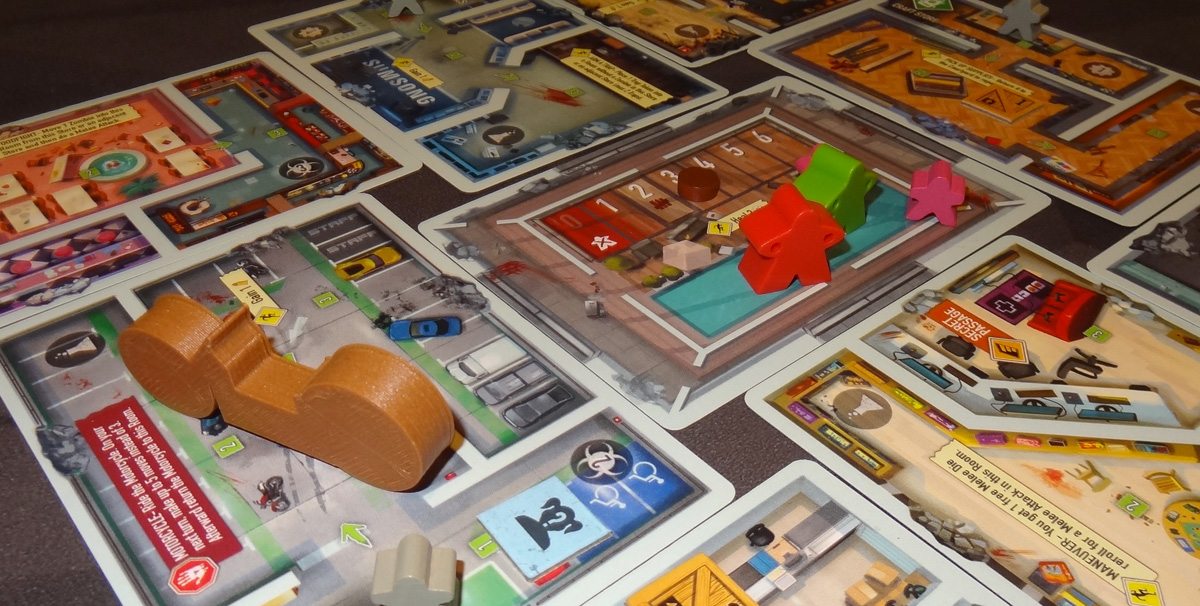
How to Play Tiny Epic Zombies
You can download a copy of the rulebook on the Kickstarter page, and there’s also a free print-and-play in case you’d like to try the game out for yourself before you decide.
The Goal
The goal of the game depends on the play mode you choose. For the human players, the goal is to complete three missions either together or individually. If there is a zombie player, their goal is to prevent the humans from winning, either by breaking down the barricades in the central courtyard, killing off human players, or just running the humans out of time.
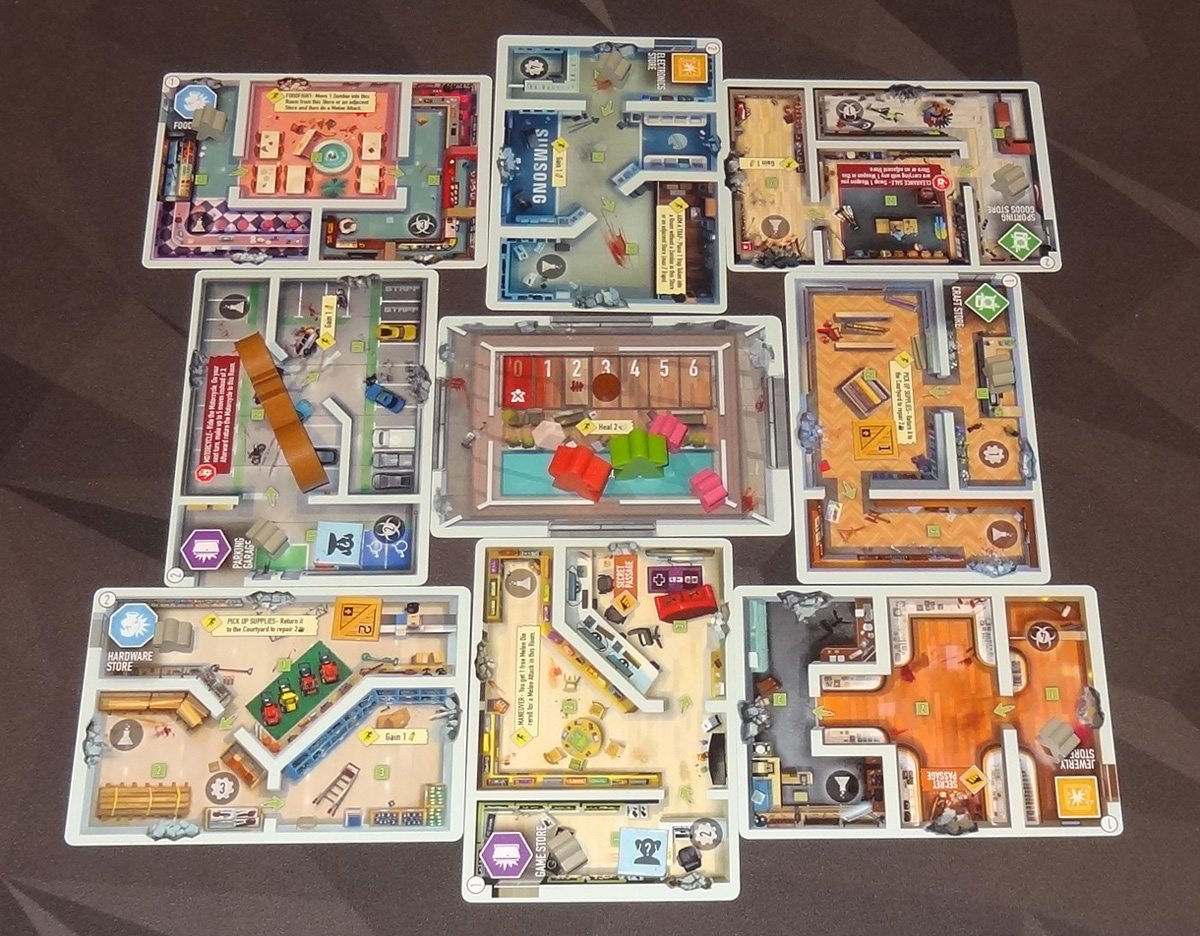
Setup
Choose a game mode:
- Cooperative humans (Team) vs. zombie player
- Cooperative humans (Leaders) vs. automated zombie
- Competitive humans (Team) vs. zombie player
- Competitive humans (Leaders) vs. automated zombie
- Solo (vs. automated zombie)
Lay the mall cards out in a grid as shown in the picture—the courtyard goes in the center, showing either the “Team” side (cooperative) or “Leader” side (competitive). The colored icons mark the entrances to each store, and should be arranged as shown so that the entrances are toward the outside of the building rather than facing the courtyard. Place all humans in the courtyard, and one zombie in each entrance room. The barricade icon should start at level 3 in the courtyard. You also place a number of survivors in the courtyard, based on the difficulty level. Place the two supplies crates into the stores on the crate icons, and the motorcycle in the Parking Garage.

Choose three scenarios at random, and turn them to the Team/Leader side as appropriate. Each scenario card may have additional setup instructions, such as placing some tokens on certain parts of the board.

Each human player takes a character card (human-side-up, of course) and uses the tokens to indicate that they have 0 wounds and 9 ammo. If your health and ammo ever meet, you die. (If there’s only one human player, the player will control two human characters.)
Form the search deck by combining the 8 crate cards, 4 surprise cards, and 12 randomly chosen hand/backpack cards. Any remaining cards are set aside as the supplies deck. The search deck includes items that players will find in stores during the course of the game, and also determines where zombies will appear.
If there is a zombie player, the zombie player takes a character card, zombie-side-up, and place a horde token on space “1” of the horde track. The zombie player also draws a starting hand of 8 cards from the search deck, and play one card face-down in front of each human player. If there is no zombie player, deal one search card face-down in front of each character.
Gameplay
Play starts with human players. Each human turn consists of up to 3 moves, and then you must search the room. Each of your moves follows this order:
- Move 1 space
- Kill 1 zombie
- Use room ability
- Collect item(s)
If you choose not to move, you don’t get to do any other portion of the move, like killing zombies or collecting things.
Move
Movement is from room to room, and you can move through walls as long as your space connects to another space through a flat wall—so although there are doorways and tunnels pictured on the cards, you aren’t restricted to movement through those openings only.

Kill Zombie
After your move, you may kill 1 zombie. If there’s a zombie in your room, you must melee attack it; otherwise, you may do a ranged attack on a zombie in an adjacent room. The melee attack automatically kills the zombie, but then you must roll the die, which may cause you to take wounds, do nothing, or allow you to take an additional move (in which case you don’t have time to stop and use the room ability). To make a ranged attack, spend one ammo and remove an adjacent zombie from the board.

Room Ability
If the entire store is clear of zombies, you may then use the room ability. Some rooms may let you pick up supplies or ammo. The room abilities with stop sign icons may only be used if you end your entire turn there. The scenarios may also give you additional options, like revealing tokens or picking up parts. If you pick up a supply crate and take it back to the courtyard, you get to repair the barricade a little and draw a card from the supplies deck.

Collect
Finally, if there are any items in the room—cards that were placed next to the store card—you may pick any or all of them up, as long as the entire store is clear of zombies. You may have as many backpack items as you want, but only one melee weapon and one ranged weapon at a time, so you will have to drop things back into the room if you have too many. Crate items are used immediately and discarded.
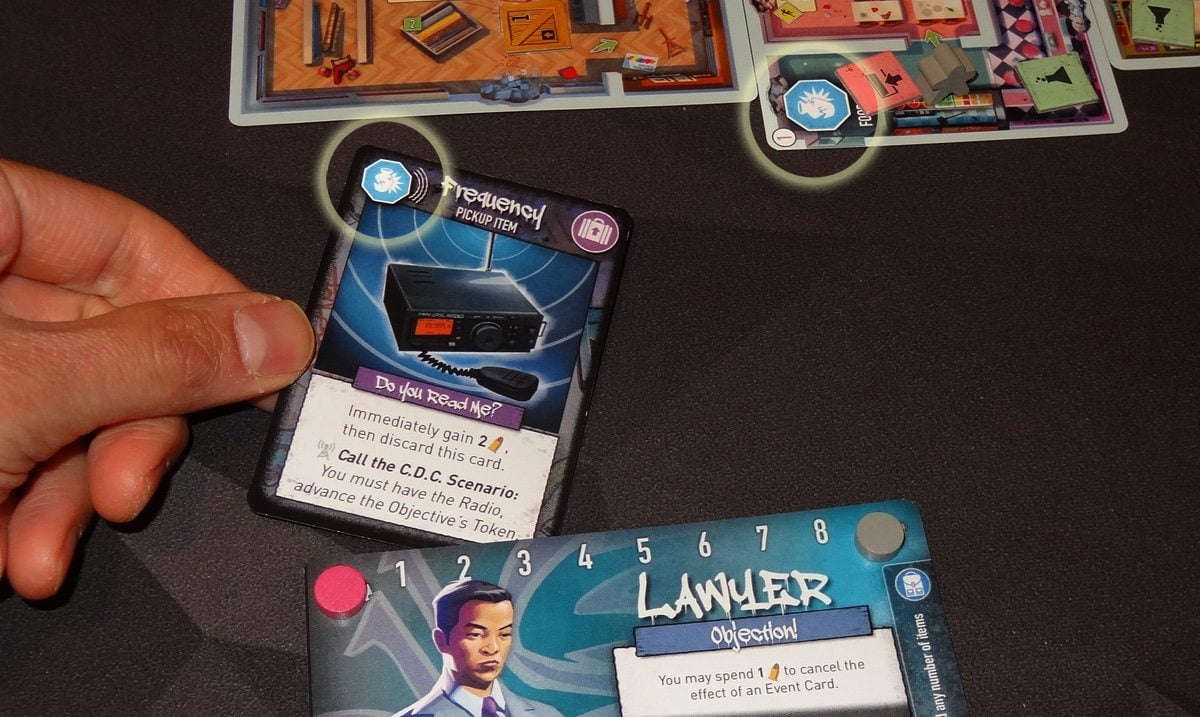
Search
At the end of your turn, you search the room. Reveal the face-down search card that is in front of you, and then place it next to your current store. (If you’re in the courtyard, you may choose a store to place it in.) The icon on the card shows which stores will get zombies—there are four different store icons, with two stores of each icon. Automated zombies will place one zombie in each matching store; the zombie player may choose whether to place one in each store or both in the same store.

Zombies always fill in from the store entrance, following the room numbers on the store. If there are already three zombies in a store, it overflows: corner stores overflow into the next store clockwise, and middle stores overflow into the courtyard. Instead of placing a zombie in the courtyard, lower the barricade level by one. If the barricade ever reaches zero, you remove one of the survivor meeples from the courtyard and then reset the barricade to 3—and if there aren’t any survivors left to remove, the humans lose the game. Also, any time a zombie enters a room with a human in it, that human is overrun—they must take a wound.

In addition, if the store icon on the search card matches the store that the active player is in, you “made noise” and the zombies get a bonus. For the automated zombie, it means that you place two zombies in each store instead of one. For the zombie player, it means they may either move a zombie one space, or else use the horde ability on the character card and then move the marker up one space. As the zombie player uses their horde ability, it will become more powerful.
If you ever need to place a zombie but there aren’t any more in the supply, one human player will take a wound.
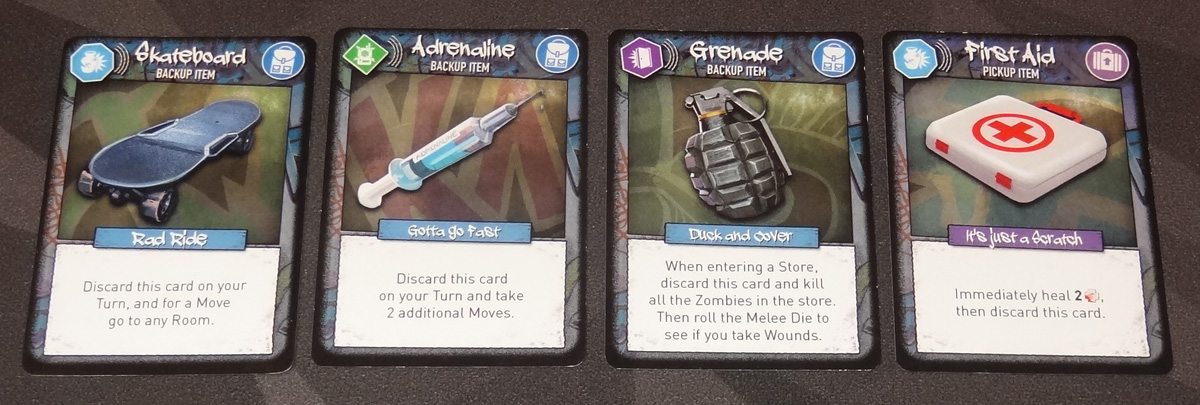
After resolving the search card, the human player will get a new search card face-down for their next turn—drawn at random if it’s an automated zombie, or chosen by the zombie player (from their hand, which gets refilled to 4 cards).
When a human’s wounds and ammo tokens meet, that human has been overcome and dies. Remove a survivor from the courtyard, and the human player draws a new character. (If there is a zombie player, they get the old character card and flip it over to the zombie side, giving them access to more powers.) If there aren’t any survivors left in the courtyard to replace the dead human, the human players lose.
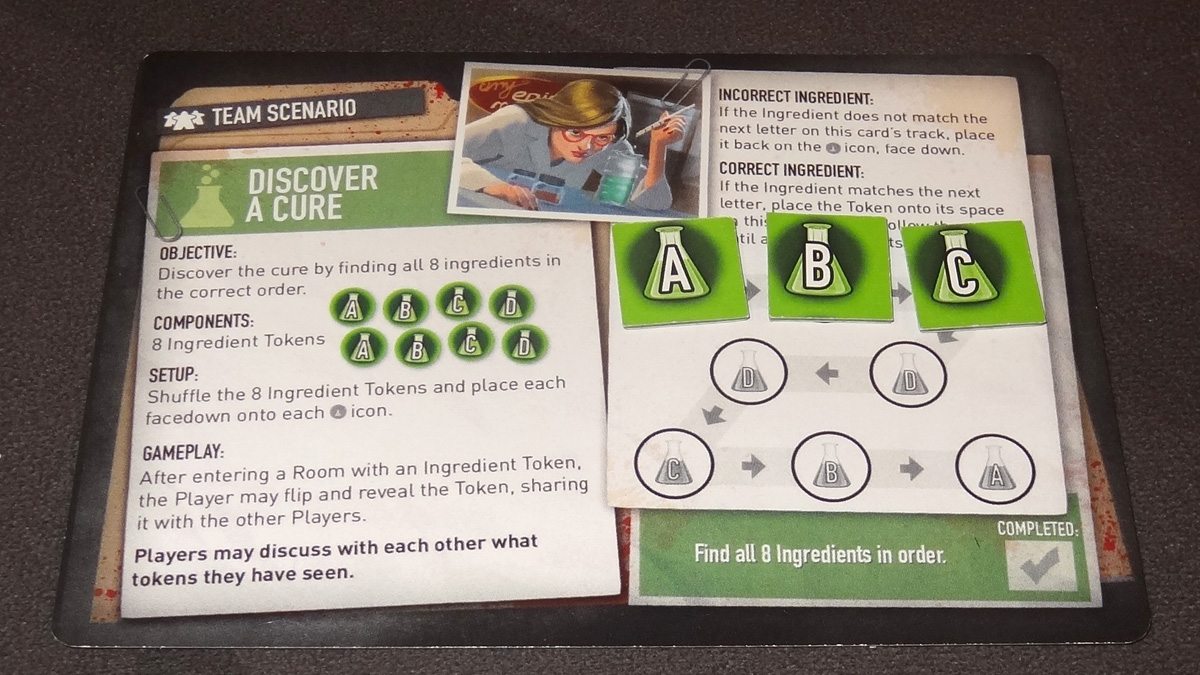
Game End
If there are no more search cards to play face-down in front of humans, the end is nigh! The game continues until each human player has taken one more turn with no search card to flip. At this point the automated zombie player adds zombies to each #1 store entrance; the zombie player gets to choose where to place two zombies.
The humans win immediately if they accomplish all 3 scenarios. In a cooperative game, the players will work together; in a competitive game, each player must achieve all 3 scenarios on their own. The zombies win if the humans run out of time, or if the barricade falls or a human is killed when there are no survivors to replace them.
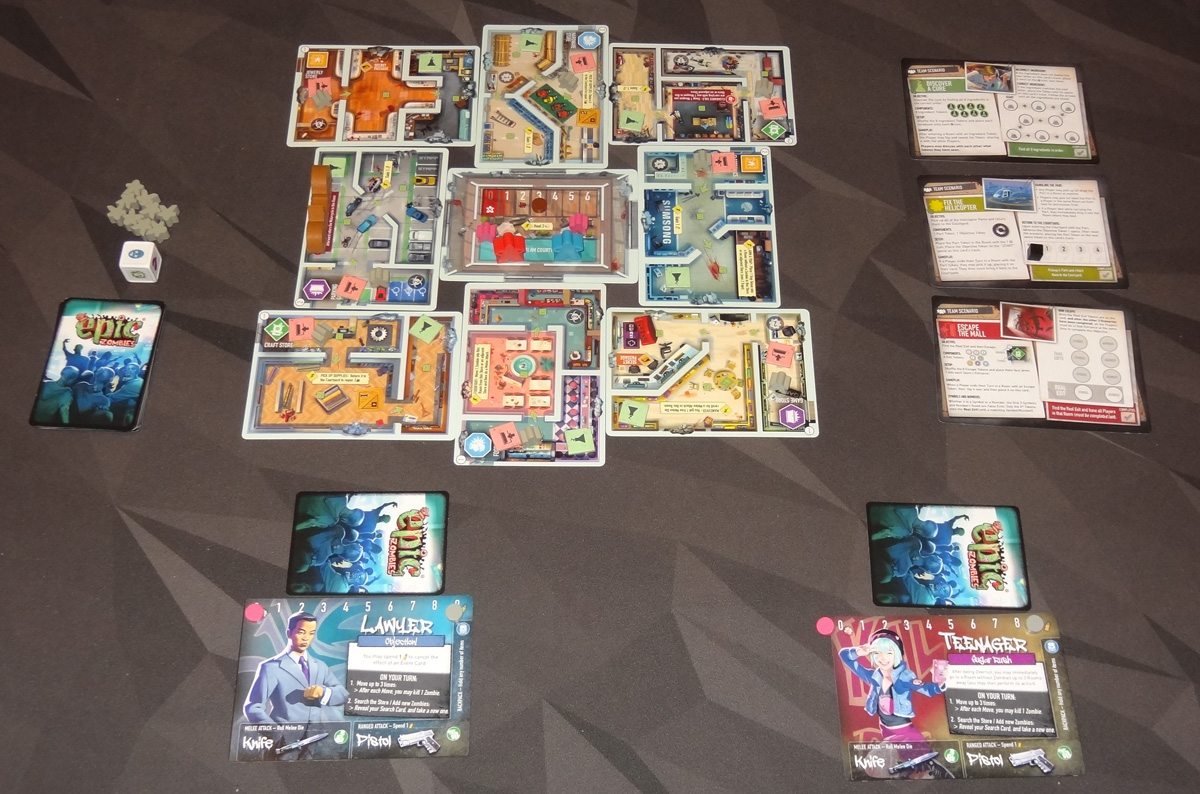
Rules Tweaks
There are some minor changes depending on the game mode, but most of the game is fairly similar. For instance, in a competitive game with a zombie player, each human character gets a survivor token (instead of placing them in the courtyard). When you die, you give your survivor token to the zombie player. The zombie player can win by collecting 4 survivor tokens, or by killing a human player who has no survivor tokens left.
In a competitive game without a zombie player, the player with the fewest wounds loses their survivor token when the barricade falls, and otherwise the game plays the same.
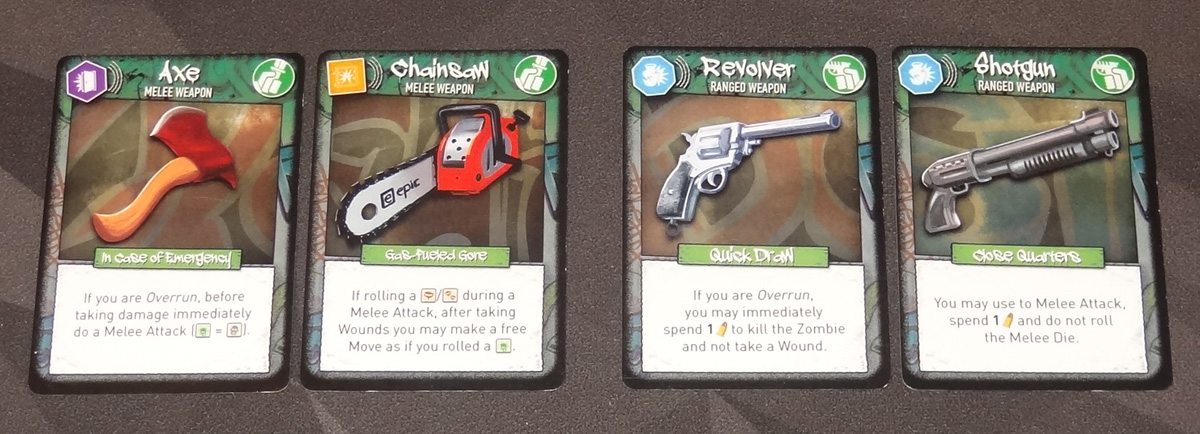
Why You Should Play Tiny Epic Zombies
Long-time GeekDad readers know that I’ve got a soft spot for zombie games. I can’t explain it, and every so often I tell myself that maybe I’ve had enough zombie games, but another one comes along and I’m hooked all over again. So, between that and my unabashed enthusiasm for the Tiny Epic game series, Tiny Epic Zombies is a pretty easy sell for me. That said, zombie games aren’t for everyone, and Tiny Epic games aren’t for everyone. Read on, and find out whether it’s for you.

So, first: the zombies. As with many other zombie games I’ve played, it does feel like the zombie player doesn’t have quite as much to as the human players: thematically appropriate, perhaps, but not always as exciting. In this instance, the zombie player ideally is trying to predict where each human player will be on their next turn, because if you guess correctly, you get to move a zombie or use a horde ability (and upgrade your horde ability). Making the right guess has the potential to make you extremely powerful. You do get a turn after every human player, so you get more turns, but your turns are much shorter, particularly if you fail to predict where the humans will be.
The zombie player wants to interfere as much as possible with the humans’ ability to do their missions, but since any fight with a zombie automatically kills it, there’s only so much you can do. Ideally you want the humans to melee attack you, because in the best case a melee fight will deliver two wounds to the human. Unfortunately, if the humans are rolling well, they may just get extra movement and can plow through even more zombies in a single turn. The other tactic appears to be overwhelming the humans with your numbers—overflowing into their barricades as often as possible, or overrunning humans to cause more wounds. Plus, if you get enough zombies on the board, you can start dealing wounds directly to the humans.
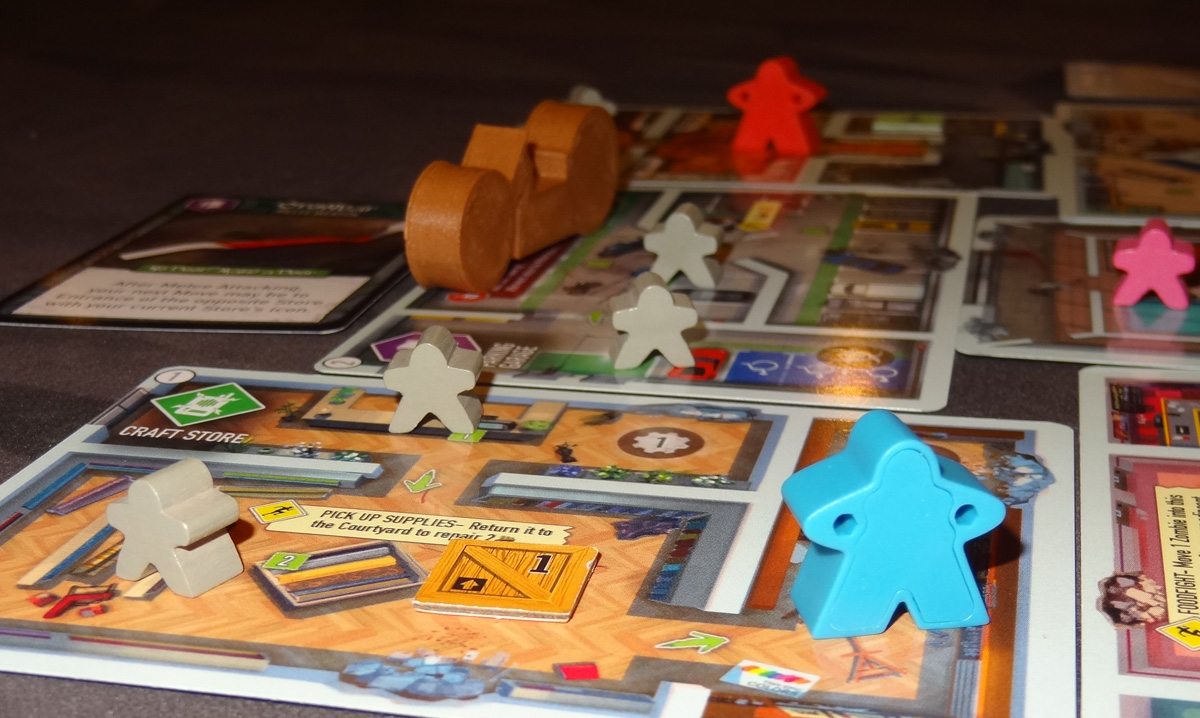
There is definitely a feeling of dread that rises when you see the growing number of zombies on the map, and I think the game does a good job with the theme. The various stores have abilities that match them, and the characters also have appropriate powers. Even the zombie powers are related to the characters.
So far in most of the games I’ve played, the humans have succeeded, so it felt like the zombies could use a leg up. I know the rules have been tweaked a bit in the zombie’s favor since my prototype copy, and generally there’s continued development and refinement before publication. One way that the rules already suggest adjusting the difficulty is through the number of survivors that start in the courtyard (in a team game)—they basically serve as extra lives, so it’s easy to adjust the difficulty by increasing or decreasing those.
My kids actually don’t like zombie games. Other than Zombie Dice, I don’t think I’ve ever managed to convince my kids to play any zombie-themed games, so it’s one that I’ve only played with some of my adult friends instead.
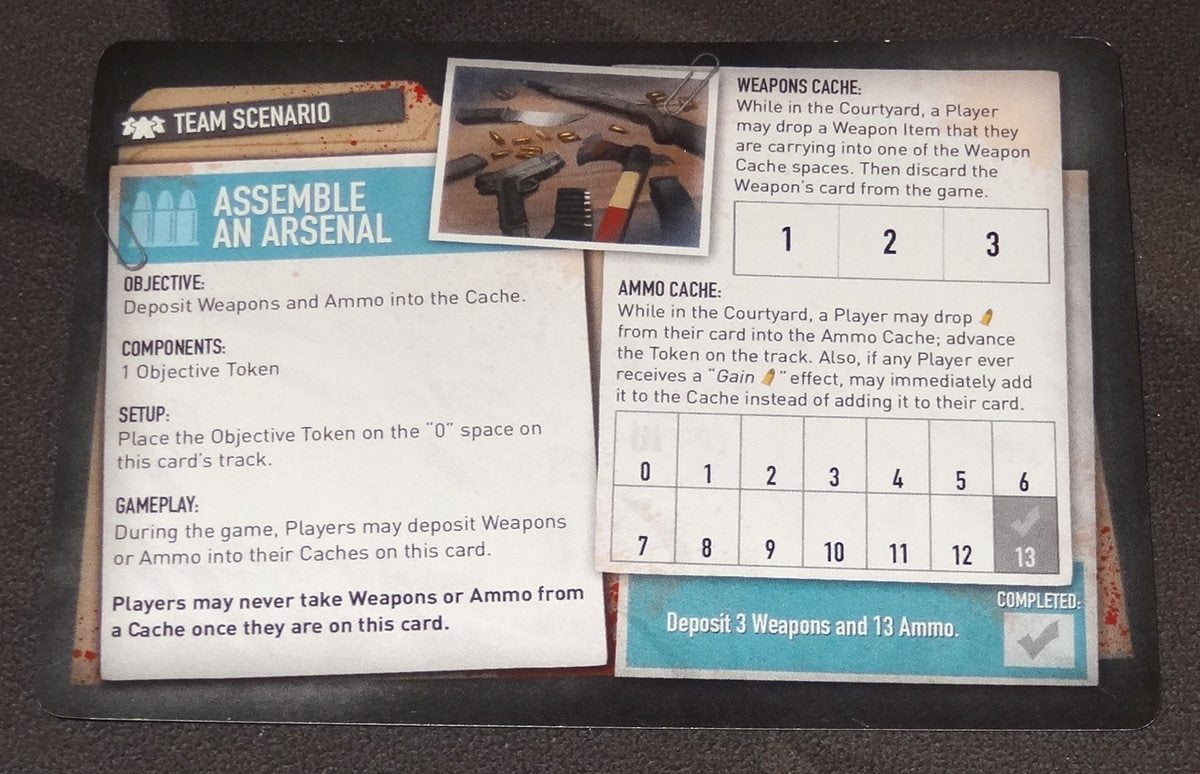
I really liked the mix of scenarios, which make every game feel a little different. “Call the C.D.C.” requires you to find the “Frequency” cards that appear, and then collect them while carrying the radio—which only one player can do at a time. “Find the Exit” has you running to all of the store exits to find the “real” exit, and everyone has to meet up there when the other scenarios are finished. “Assemble an Arsenal” requires you to relinquish some of your hard-earned weapons and ammo.
The switch from cooperative to competitive is also nicely done. Basically, the competitive versions are slightly shorter versions of the cooperative version. So “Assemble an Arsenal” requires you to stash one weapon and less ammo than the cooperative version, but you have to do it on your own.

The various modes of player give a lot of flexibility: some people like playing the zombie and some don’t. This way, if nobody wants to be a zombie, you can still play. Feeling friendly? Play cooperative. Feeling combative? Play competitive. The game does scale nicely: with more players, the humans have access to more player powers and can spread out more, but each player gets fewer turns before time runs out, since the search deck has the same number of cards no matter what. That flexibility is pretty amazing for a $20 game.

As far as Tiny Epic games go, this one is comparable to the previous titles in game length and components. It might not be quite as complex rules-wise as some of the more involved titles, and may be a nice entry point for those curious about the series (as long as you like zombies). Gamelyn Games has been pretty successful in its Kickstarter campaigns so far and the series has garnered a loyal following, which means that every Tiny Epic game ends up with even more components by the end of the campaign. Whether these fans will be divided on the zombie theme remains to be seen, but I’ve seen some of the stretch goal content and it would definitely increase the replayability even more.
If you like zombie games, I think backing Tiny Epic Zombies is, ahem, a no-brainer. It won’t replace your huge minis-filled, hour-plus zombie games, but it lets you take several options in a tiny package: co-op, solo, competitive, with or without a zombie player. The artwork is excellent and I expect the components will be top-notch.
For more information or to make a pledge, visit the Kickstarter page!
Click here to see all our tabletop game reviews.
If you’d like to stay up-to-date with all of our tabletop gaming coverage, please copy this link and add it to your RSS reader.
Disclosure: GeekDad received a copy of this game for review purposes.
